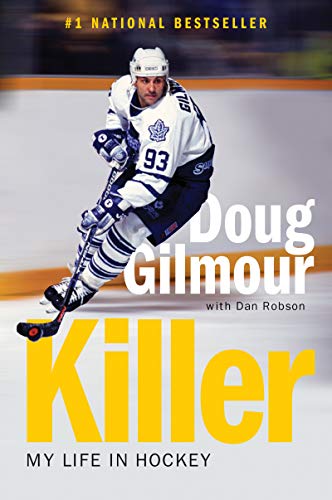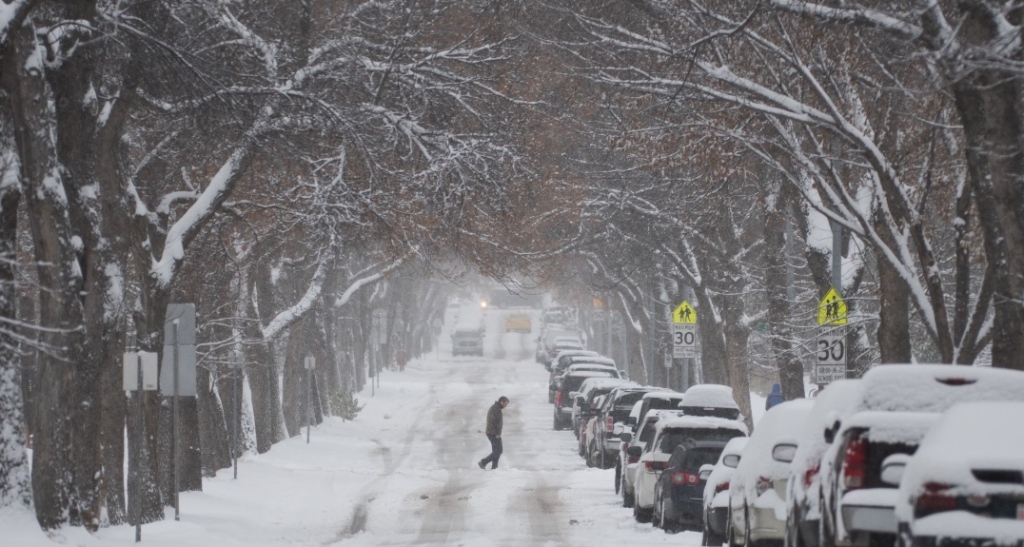If you were a fan of the Calgary Flames in the late 1980’s or the Toronto Maple Leafs in the early 90s, Doug Gilmour was likley one of your favorite players as he was a significant part of both teams success during those years. In Killer (HarperCollins, 2017), he tells stories of growing up in Kingston to becoming an all-star NHL forward.
Undersized for the 80’s, Gilmour was a 7th round draft choice of the St. Louis Blues who credits Brian Sutter and Jacques Demers as the individuals who first gave him the tips and tools to succeed at the NHL level. “Killer” really came to be regarded as one of the league’s top players in Calgary, a key member of the 1989 Stanley Cup winners. After a block-buster 10 player deal with Toronto, Gilmore than became a key figure in the Leafs resurgence in the mid 90’s. Along with way, he tells of the key figures he counts as friends from those days: Cliff Fletcher, Wendel Clark, and (the late) Pat bursn among others. Gilmore finished his 1474 games in the NHL with stops in New Jersey, Montreal, Buffalo, Chicago and Toronto before retiring in 2003 due to the wear and tear on his now 40 year old body.
Gilmour takes very little about his personal life, though the pride in his five children is evident. Of course, his parents and siblings, especially his father, were significant encouragers throughout his career and he was glad to honour them at his Hockey Hall of Fame induction ceremony.
Jim Robson’s work with Gilmour makes Killer an enjoyable read about a hard-working guy overcoming his nay-sayers to become an NHL star. I recommend it!
If you appreciated this book review, you may also like:
- Book Review: Shift Work (Simon & Shuster 2015) by Tie Domi with Jim Lang
- Book Review: Undrafted: Nick Kypreos (Simon & Schuster, 2020) with Perry Lefko
- Book Review: Burke’s Law: My Life in Hockey (Viking, 2020) by Brian Burke with Stephen Brunt
- Book Review: Catch 22 (Random House, 2020) by Rick Vaive with Scott Morrison
As always, your comments & feedback below are welcome!
The Scriptures contain many passages where God’s view of life and His plans seems to be upside down from the natural way a person thinks. As God says throught the prophet, Isaiah (55:8) “For my thoughts are your thoughts, neither are your ways my ways.”
For example, in speaking of the restoration of God’s people He God says,
“I will turn their mourning into joy,
I will comfort them,
and give them gladness for sorrow.”
Jeremiah 31:13 (ESV)
Yet it seems North American (Western) Christianity has their own version of Upside Down Christianity. God’s people have put
- favor with people before favor with Christ,
- God’s “grace” before God’s glory,
- justice before generosity,
- liberty before love for one another.
- self-preservation before service,
- and the crown before the cross.
I trust you will join me in repenting of this version of upside down Christianity, and Jesus’ Holy Spirit to help you live with His priorities in heart and mind.
As always, your comments, feedback – and additions – are welcomed in the space provided below.
If you appreciate the content of this post, “Like” and share it with your social media circle.
To receive notification when the next article appears on the Leadership & Life blog, enter your email address and click “Follow” in the space provided.
As my friend, Krista Ewert shares, frigid is a most appropriate word to start the #2022WritingChallenge – both in terms of the weather in Western Canada, as well as the continuing spread of CoronaVirus variants, keeping our world “cloistered” and many concerned, if not fearful of the pandemic’s continuation.
While the below 30 degrees (Celsius) temperatures outside may be keeping some Canadians locked in their homes trying to stay warm, others are “locked down” due to the spread of COVID, most recently the more transmissable, though less symptomatically troublesome, omicron variant. Not just north of the 49th parallel, but many parts of the world are “cold” places to visit, with bare streets, empty schools and businesses, and minimal social interaction possible. As has been widely attested since March 2020, this is not healthy for the body, mind, or spirit of any person at any age in life.
While most people have ways and means necessary to provide additional heat in their houses, how can one warm up the temperature socially when visiting outside is impossible and people are encouraged not to gather. Here are a few suggestions…
Phone a friend
Recognizing calling someone to talk voice-to-voice is about as “old-school” a method as anyone alive can imagine, there is value in simply picking up your phone, calling a family member or friend, and talking over the phone. Sometimes the simplest of pleasures are still the most enriching!
Virtual Communication
Fortunately, we live in a time where voice-to-voice calls are considered basic. Many people use some “app” to communicate with their family and/or friends enabling them to also see their faces, and even allow multiple people in the same home to visit together. A family may host a “zoom meeting” with grandma & grandpa – and uncles and aunts and cousins too. Or plan a “GoToMeeting” allowing friends to connect virtually, in far off parts of the province/state, country, or internationally. Of course, “What’s App” and “FaceTime” or “Facebook Video Messenger” allow these types of conversations to happen too.
While children and adults may not be able to play together, there are ways family and friends of all ages can still play games with one another available online too. Not that its the same as seeing each other in person, but gaming in various forms can allow for social connections to remain, for young and older alike.
Planned Parties
Our daughters both have birthdays around Christmas (mid-December and early January). In other words, the last two years, birthday parties with friends have been “cancelled” as indoor events and having on outdoor party is not feasible in the middle of winter. Nonetheless, one group of friends arranged a “drive-by” party where parent’s drove by our house, stopped for a few minutes so their respective daughters could come out and sing “Happy Birthday” to our daughter, and then dropped off gifts at the doorstep. It wasn’t the joy of a full birthday party, yet it made the birthday memorable in a special way!
Likewise, graduations happen differently during a pandemic. Instead of the whole school community coming to the auditorium for a celebration, after a small service with the formal presentation of diplomas by teachers and school adminstrators – perhaps with a limited number of invited guests in attendance – graduates drove around town in individual vehicles and the community could come out of their homes and wave, honk, and cheer the grads as they drove by.
These are just two examples of how celebrations can still happen, even in freezing conditions. It may take some planning, but one can still enjoy a party with a bit of preparation.
So… don’t let the chilly climate freeze your social life. Take proactive steps to continue to build community and capitalize on the most important, longest lasting, and highest return investment – relationships.
As always, your feedback is welcome in the comments below. Sharing your own personal stories of community building during these cool times will be especially appreciated.
If you like this post, share it with a friend through your social media channels.
To receive notifications when other posts like this are added to the Leadership & Life blog, enter your email address in the space provided and click “Subscribe.”
If you enjoyed this post, you may also like:
- #2021WritingChallenge Words – Vulnerable, Return, Reset, etc…
Read other posts in the #2021WritingChallenge: Intend, Grounded, Focus, Balance, Purpose, Awaken, Inquire, Simplify, Dig, Cultivate, Reflect, Grieve, Believe, Quiet, Stretch, Lean, Ignite, Journey Learn, Commune, Encourage, Comfort, Allow, Release, Surrender, Rest, Dwell, & Reset.
Do you love a roller coaster ride?
While I have never been on a physical roller coaster ride, I feel like the past 14 months of life have been a roller coaster. and that’s just in relation to my personal health, not including the unexpected death of friends or all the craziness of COVID19.
Some people are “addicted” to the adrenaline rush of a roller coaster. These up and down rides are the reason they rush to amusements parks as soon as they open each spring and plan a vacation with stops along the way to “get a break” from driving. Indeed, there is a physiological rush of dopamine in the nervous system, causing a sense of pleasure and then peacefulness.
Of course, when the body experience too many adrenaline surges, it can be dangerous for one’s physical, mental, and emotional health. (see the excellent book The Body Keeps the Score by Bessel van der Kolk)
The thrill of the roller coast is the ups and downs, over and backs, around and around a winding track – make the adrenaline rush constant for a couple minutes and lead to the euphoric status.
In a similar manner, every person experiences highs and lows and twists and turns over the course of one’s life journey. Certainly there are moments of true excitement – graduating, getting married, having a child(ren), seeing any of those children succeed at a task/project important to them, and other highlight occurrences. At the same time, there are the discouraging situations and occasions in everyone’s lives. It may be the ending of a relationship, death of a parent, sibling or close friend, personal health or financial issues, etc.
At some point, each individual experiences the roller coast of life. Emotions accentuate when highs and lows occur in close proximity. For example, a child graduates from one week and the next week you are present at a parent’s death. Again, each of these highs and lows are not in themselves necessarily problematic, yet the sudden range of emotions leaves one feeling similar – over a period of weeks, even months – as the rushes of adrenaline are followed by a sudden drop.
Sometimes, individuals have the physical, relational and spiritual resources already in their lives to walk through these life events, feeling the full range of emotions, yet can come off the roller coaster with minimal euphoria, depression or light-headedness. At other times – and sometimes even when these building blocks are in place – people need take some time off from work to recover from the succession of these life events and process the variety of feelings. Likewise, sometimes a good counselor assists in the process of dealing with life’s disappointments. Unfortunately, there are some folks for whom the triumphs and tragedies become overwhelming and either they harm themselves and hurt others around them deeply. The rollercoaster makes them more than noxious, they are crushed under the weight of life’s experiences.
Just as the roller coaster ride happens for individuals, the it can also happen in organizations. Sometimes, the factors are part of the natural business cycle – seasons of high activity, and seasons of low movement. Once in a while, the organization chooses to intentionally go fast-forward for a period of time, and then other times to move slowly – realizing it will feel like a roller coaster for a while. Outside factors can also come together (eg. economic recession, global pandemic) resulting in ups and downs in any company or non-profit.
Even as individuals respond differently depending, organization reactions vary as well. Some meet the challenges of the roller coaster and ride through them successfully, even joyfully. Others, require a period of re-adjustment in some fashion to survive. Sadly, a few go down and close.
While nobody wishes the roller coaster effect for any person or corporation, it will happen in life. Start preparing now for the roller coaster so that you can enjoy the ride!
As always, your comments & feedback are welcomed in the space provided below.
If you appreciate the content of this post, “Like” and share it with your social media circle.
To receive notification when the next article appears on the Leadership & Life blog, enter your email address and click “Follow” in the space provided.
Other posts you might be interested in such as:
Associates with Barna research, Stephanie Shackelford and Bill Denzel, describe how individuals, no matter age or stage in life, can identify the purpose for which God made them. Combining their experience as career counselors with the insights from Barna research, they methodically set forward the path to understanding one’s true identity and purpose for living. Stories of individuals and their choices support the principles the authors identify well. While their specific worldview (Judeo-Christian) provides a foundation for their understanding of human identity and purpose, one could hold to a different (or non-) faith perspective and still find the knowledge and insight offered valuable.
I recommend You on Purpose (Baker, 2021) for high school and college students, as well as young adults beginning their work experience.
If you appreciated this book review, you may also want to check out my reviews for similar books such as:
- The Powerful Purpose Introverts by Holly Gerth (Baker, 2021)
- A Greater Story by Sam Collier (Baker, 2020)
- Uniquely You by Ron Kitchens (Baker, 2019)
- The 5 Money Personalities by Scott & Bethany Palmer (Thomas Nelson, 2012)
This book was provided at no cost in exchange for an unbiased blog review, courtesy of the Nuts About Books blog review program.
As always, your comments about this book, my review, or other related matters, are welcome in the space provided below.





